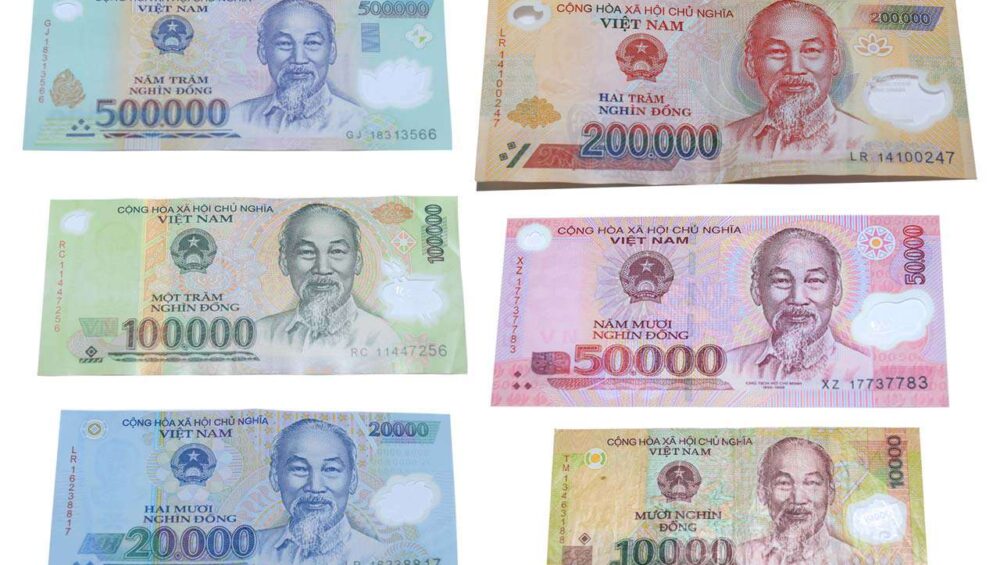When arriving in a new country—especially Vietnam, which uses its own currency, the Vietnamese dong (VND)—financial preparation and money exchange are essential parts of your travel journey. Without proper research, travelers can easily lose a significant amount due to poor exchange rates or choosing the wrong places to exchange money.
This article will help you better understand Vietnam’s currency, how to exchange money effectively and safely, and offer useful tips to minimize risks and save during your trip.
- Introduction to Vietnamese Currency
The Vietnamese dong (symbol: VND) is the official and only currency used in Vietnam. Since 2003, the country has adopted polymer banknotes, which are more durable and feature vibrant colors along with anti-counterfeit security elements such as hidden images, metallic strips, and color-shifting ink.
Common Denominations
Vietnamese currency comes in denominations ranging from 1,000 VND to 500,000 VND. Smaller denominations like 1,000, 2,000, and 5,000 VND are rarely used in daily transactions.
Quick Exchange Rate Estimation
The exchange rate fluctuates slightly day to day, but you can roughly estimate:
- 1 USD ≈ 24,000 VND
- 1 EUR ≈ 26,000 VND
- 1,000 KRW ≈ 20,000 VND
A quick trick is to drop four zeros and divide by 2.5 to estimate the price in USD. For example, a meal that costs 100,000 VND is approximately 4 USD.
- Financial Preparation Before Coming to Vietnam
Proper financial planning ensures more control and safety during your trip. Here are some key points:
Plan Your Budget
Estimate daily expenses: meals, accommodations, transportation, entry fees, and shopping.
Add 20% extra as a contingency for unexpected costs.
Cash vs. Cards: Maintain a Balance
Bring a mix of cash and payment cards at a 60:40 ratio.
While USD is accepted in some places, VND is the primary currency. It’s advisable to exchange a small amount into VND in your home country for initial expenses like airport transport.
Customs Regulations
Visitors carrying over 5,000 USD or equivalent must declare it at customs. To ensure safety and compliance, use travel cards or reputable international money transfer services.
- Common Currency Exchange Methods in Vietnam
Travelers have several options depending on convenience, safety, and exchange rates.
a. At Banks
The safest and most transparent method.
Major banks like Vietcombank, BIDV, and Agribank offer currency exchange services.
Requirements: Passport; some banks may also require flight tickets.
Operating hours: Monday to Friday, 8:00 AM – 4:00 PM.
b. At Gold and Jewelry Shops
Popular in Hanoi (Hà Trung Street) and Ho Chi Minh City (Lê Thánh Tôn, Nguyễn An Ninh).
Often better rates than banks and lower/no service fees.
Only use reputable shops and count your money carefully on-site.
c. At Hotels
Convenient but usually offers lower exchange rates.
Good for quick, small exchanges when you’re in a rush.
d. At Tourist Areas
Exchange booths are available in hotspots like Hanoi’s Old Quarter or Hội An.
Rates may be higher and hidden fees more common—only exchange small amounts and double-check before confirming.
- How to Avoid High Exchange Fees
Many travelers unknowingly lose money through poor rates or hidden service charges. Here’s how to avoid that:
Understand the Fees
- Commission fees: 0.5% – 2% of the total exchanged.
- Fixed service fees: 15,000 – 50,000 VND per transaction.
- Exchange rate margins: Some places offer unfavorable rates to make up for “no fee” claims.
Avoid Airport Exchanges
Rates at airports are usually 5–10% worse than in city centers.
Exchange only a small amount at the airport for essentials, and find better rates later.
Compare Rates Before Exchanging
Check the State Bank of Vietnam’s official website or use apps like XE or Wise for real-time rates.
Larger denominations (e.g., $100 USD) often get better rates than smaller ones.
- How to Avoid Currency Exchange Risks
How to Spot Fake Money
Check for watermarks, security threads, and color-shifting ink by tilting the bill or holding it up to light.
Feel the texture—real polymer notes usually have raised printing in certain areas.
Common Scams
- Swapping for smaller denominations.
- Short-changing or adding undisclosed “service” fees.
- Misleading exchange rates significantly different from market rates.
Safe Exchange Tips
Always count your money immediately and check both sides of the notes.
Know the expected amount based on the current rate before exchanging.
If you suspect a scam, cancel the transaction and report it to local authorities or find another trusted location.
- Using ATMs, Credit Cards, and E-Wallets
Vietnam’s payment systems are becoming increasingly modern and tourist-friendly.
ATMs and Credit Cards
Widely available in major cities, hotels, and shopping centers.
Banks like Vietcombank, Techcombank, and BIDV have extensive ATM networks.
Check with your bank for international withdrawal fees before use.
E-Wallet Apps
E-wallets like MoMo, ZaloPay, and ViettelPay are becoming widely accepted at restaurants, supermarkets, and tourist spots.
Some hotels and stores also accept Apple Pay or international cards via POS terminals.
International Money Transfer Services
Services like Western Union and MoneyGram are available nationwide.
Ideal for receiving emergency funds or sending money—compare rates and fees beforehand.
Conclusion
Exchanging currency in Vietnam is straightforward with proper preparation and reliable information. Always be aware of exchange rates, check for hidden fees, avoid shady money changers, and make use of modern payment methods to enhance your travel experience.
With good planning, you not only save money but also protect your finances from unnecessary risks. Wishing you a safe, smooth, and memorable journey through beautiful Vietnam!




